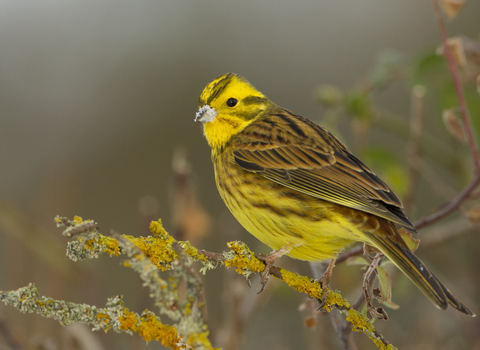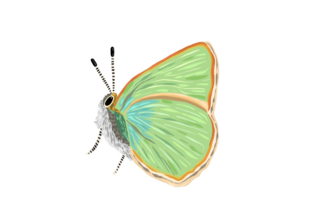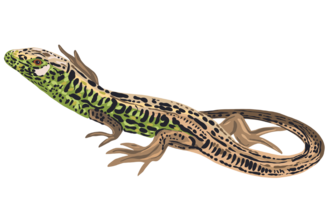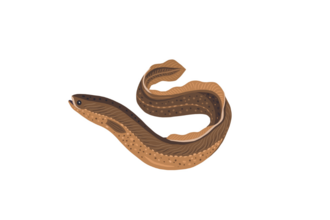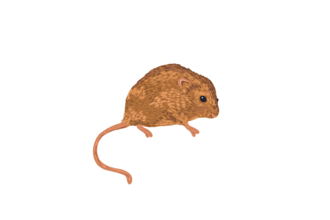Every spring and summer Surrey’s hedgerows, woodland edges and farmland should be brimming with life, with brightly-coloured birds and butterflies lifting the spirits of anyone who cares to look and listen...
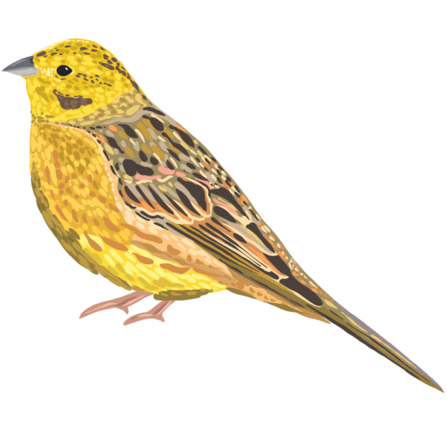
Bea Baranowska Illustration
...on a good day, it can almost seem that the hedgerow itself is starting to talk. No species represents this idyll more perfectly than the Yellowhammer, with the bright yellow plumage of the male standing out as he sings his jaunty '..little-bit-of-bread-&-no-cheese' song from a high vantage point.
The canary-yellow heads of males are especially vibrant in summer; in winter when Yellowhammers join mixed flocks with other buntings, finches and sparrows to feed on waste seeds on farmland, their colouration is duller. The females’ plumage is more subdued, but all buntings are beautiful birds.
To catch a glimpse of these bright stars of the countryside, try visiting Elstead, or nearby Royal or Bagmoor Commons - lowland heathland managed by the Trust on behalf of the MoD - early one spring or summer morning when the males are most likely to be singing. Find out more about the Yellowhammer here.
Why they matter
As well as the insects that are fed to chicks in large number during the breeding season, Yellowhammers for the most part subsist on a varied diet of seeds including Common Nettle, docks and knotgrasses, Common Chickweed, and sown wheat and oats. It therefore stands to reason that their presence is a good indicator of a healthy diversity of native vegetation throughout the height of the hedgerow, which also contributes to its density, further encouraging these birds to nest.
Because of intensive farming, the loss of hundreds of kilometres of hedgerows and the tendency to cut the remainder too frequently, this sparrow-sized bunting is now a diminishing sight in our county – just like many other farmland birds that not so long ago would have been a daily feature of country life.
Nationally, Yellowhammer numbers have declined more than 50% over the last 25 years, placing them on the RSPB's Red List of birds along with many other farmland species.
How we're helping
The good news is that these birds could bounce back quickly if the right action is taken. In one study carried out in Northern Ireland by the RSPB in 2018, participating farmers planted wild bird cover, grew taller hedges and allowed field margins of rough vegetation to provide shelter and food. The survey results showed Yellowhammer numbers increased by almost eighty percent, with numbers of Linnets and Tree Sparrows also undergoing a revival.
Throughout our reserves, for example at The Moors and Spynes Mere, we work hard to maintain a diversity of environments to suit the needs of birds like Yellowhammers, with ‘messy’ scrub, hedgerows cut to varying levels and plant-rich field edges providing food, shelter and nest sites. Through our Hedgerow Heritage project, we’re restoring and extending the county’s network of nature-friendly hedgerows and working with local people and landowners to resurrect the hedge-laying and other management skills that will keep them in good condition for future generations.
And we are working with farmers and land managers to help them get the most out of their land, for both nature and people, by signposting to funding to help deliver alternative methods to the intensive farming practices that have done so much damage to wildlife. This, of course, helps us all to benefit by cleaner air and water from a landscape that reduces the impacts of climate change, such as seasonal drought and flash flooding.
Other species in need
The decline of species like the Nightingale, Yellowhammer, and European Eel is not just a concern – it’s a call to action. These iconic creatures, along with others like the Harvest Mouse and hairstreak butterflies, need our help to thrive once again in their natural habitats. To find out more about each of these species and how we're helping them, click below.

